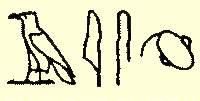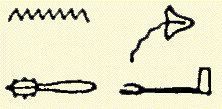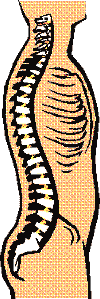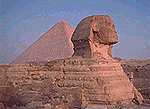 | ||
 | The Edwin Smith Surgical Papyrus The first use of "neuro" words in recorded history |  |
 | ||
 | The Edwin Smith Surgical Papyrus The first use of "neuro" words in recorded history |  |
|
I'm thinking of a word... A simple word... An important word...  A word for the most important organ in the body...
A word for the most important organ in the body...
|
 | The brain was not always held in high regard. The Greek philosopher, Aristotle, thought the heart, not the brain, was the location of intelligence and thought. The ancient Egyptians also did not think much of the brain. In fact, when creating a mummy, the Egyptians scooped out the brain through the nostrils and threw it away. However, the heart and other internal organs were removed carefully and preserved. These organs were then placed back into the body or into jars that were set next to the body. |
| Nevertheless, the ancient Egyptians are responsible for the oldest written record using the word "brain" and have provided the first written accounts of the anatomy of the brain, the meninges (coverings of the brain) and cerebrospinal fluid. The word "brain" appears on an ancient paper-like document (a "papyrus") called the Edwin Smith Surgical Papyrus. This document was written around the year 1700 BC, but is based on texts that go back to about 3000 BC. This document is considered to be the first medical document in the history of mankind. It is possible that the papyrus was written by the great Egyptian physician named Imhotep. |  Statue of Imhotep |
A Papyrus |
 Hieroglyphic for "Brain" |
|
The papyrus is a description of 48 cases that were written by an Egyptian
surgeon thousands of years ago. The papyrus is about 4.68 meters (15 ft.,
3.5 in.) long and 32.5 to 33 cm (13 in.) wide. Because some of the
document is missing, the original papyrus was probably at least 5 meters
long. Several cases are important to neuroscience because they discuss the
brain, meninges (coverings of the brain), spinal cord, and cerebrospinal
fluid for the first time in recorded history. The surgical papyrus is named after Edwin Smith, an American Egyptologist who was born in 1822 and died in 1906. On January 20, 1862 in the city of Luxor, Smith bought the surgical papyrus from a dealer named Mustapha Aga. After Smith died, his daughter, Leonora Smith, gave the papyrus to The New York Historical Society. In 1920, James Henry Breasted, founder of the Oriental Institute of Chicago, was asked to translate the papyrus. Finally, in 1930, Dr. Breasted published the English translation for The New York Historical Society (University of Chicago Press.) According to Arlene Shaner, reference librarian of historical collections at The New York Academy of Medicine, the papyrus was sent to the Brooklyn Museum in 1938. Ten years later, the Museum purchased most of the Egyptian artifacts from the Society. At that time, however, the directors of the Society and of the Museum decided that the papyrus really belonged at The New York Academy of Medicine. The papyrus has been part of The New York Academy of Medicine collections since December 2, 1948. (Note: I found a dusty copy of the 1930 publication in a back corner of the University of Washington Health Sciences Library.)
|

|
|
The 48 cases contained within the Edwin Smith Surgical
Papyrus concern:
It is likely that the patients described in the 48 cases were injured by falls (maybe from working on monuments or buildings) or were victims of battle (many wounds appear to be caused by spears, clubs or daggers.) The brain is mentioned 7 times throughout the papyrus. However, there is no use of the word "nerve." Scholars of medical history have been impressed with the rational, scientific approach to diagnosing and treating the 48 patients. The methods used are based on rational observation and practical treatment and are for the most part, free of "magic" and superstition.
|

|
|
Each case is presented in a logical manner:
|
|
Let's look at some of the cases that concern the nervous system.
Case 6Case 6: A gaping wound in the head, fracture of the skull and opening of the meninges. This case describes the:
 "Fluid" in the Interior of the Head Case 6 was "An ailment not to be treated."
Case 8Case 8: Fracture of the skull with no visible external injury. Apparently this patient injured his head, but the skin remained somewhat undamaged. This case is important because it describes which side of the body is affected by a head injury. In this patient, there was abnormal eye movement and paralysis of the arm and leg on the side of the body that was the same as the head injury. Because the right side of the brain controls the left side of the body and the left side of the brain controls the right side of the body, it is thought that the damage to the brain was caused by a contracoup injury. A contracoup occurs when impact to one side of the head pushes the brain within the skull such that the brain hits the opposite side of the skull. This results in brain damage on the side opposite to the side receiving the impact. The description of this case indicates that the Egyptian surgeon may have known that the brain controlled movement.Case 8 was "An ailment not to be treated."
Case 22
 Case 22: Fracture of the temporal bone (of the skull). This patient
could not speak and this case is thought to be the first to document aphasia. If this is a description of aphasia, it would
pre-date the famous work on aphasia by Paul Broca (1861) by thousands
of years!
Case 22: Fracture of the temporal bone (of the skull). This patient
could not speak and this case is thought to be the first to document aphasia. If this is a description of aphasia, it would
pre-date the famous work on aphasia by Paul Broca (1861) by thousands
of years!Case 22 was "An ailment not to be treated."
Cases 31 and 33Case 31: Dislocation of cervical vertebra; Case 33: Crushed cervical vertebra. Both cases describe paralysis and sensory problems caused by injuries to the backbone.Cases 31 and 33 were both classified as "An ailment not to be treated."
Case 48Case 48 is the last case and describes a sprain in the spinal vertebra. When the patient was asked to move his legs, the surgeon noted that this caused pain. The text of case 48 comes to an unexpected stop in the middle of a sentence. This suggests that there may have been more cases in the original papyrus.Case 48 was "An ailment which I will treat."
|
 Our
understanding of the brain has come a long way since 3000 BC. Now,
through brain imaging techniques such as positron emission tomography
(PET) and magnetic resonance imaging, scientists can
"look" at how the brain works. Neuroscientists also know what many parts
of the brain do, what brain cells look like and how drugs affect the
nervous system. However, many mysteries
of the mind still remain: Our
understanding of the brain has come a long way since 3000 BC. Now,
through brain imaging techniques such as positron emission tomography
(PET) and magnetic resonance imaging, scientists can
"look" at how the brain works. Neuroscientists also know what many parts
of the brain do, what brain cells look like and how drugs affect the
nervous system. However, many mysteries
of the mind still remain: These are just a few of the many unanswered questions, but like case 48 in the papyrus, this page is coming to a sudden...
|
For more
information on the
Edwin Smith Surgical Papyrus and ancient Egyptian
medicine, see:
|
References:
|

| BACK TO: | Exploring the Nervous System | Table of Contents |
![[email]](./gif/menue.gif) Send E-mail |
 Get Newsletter |
 Search Pages |
 Donate to Neuroscience for Kids |